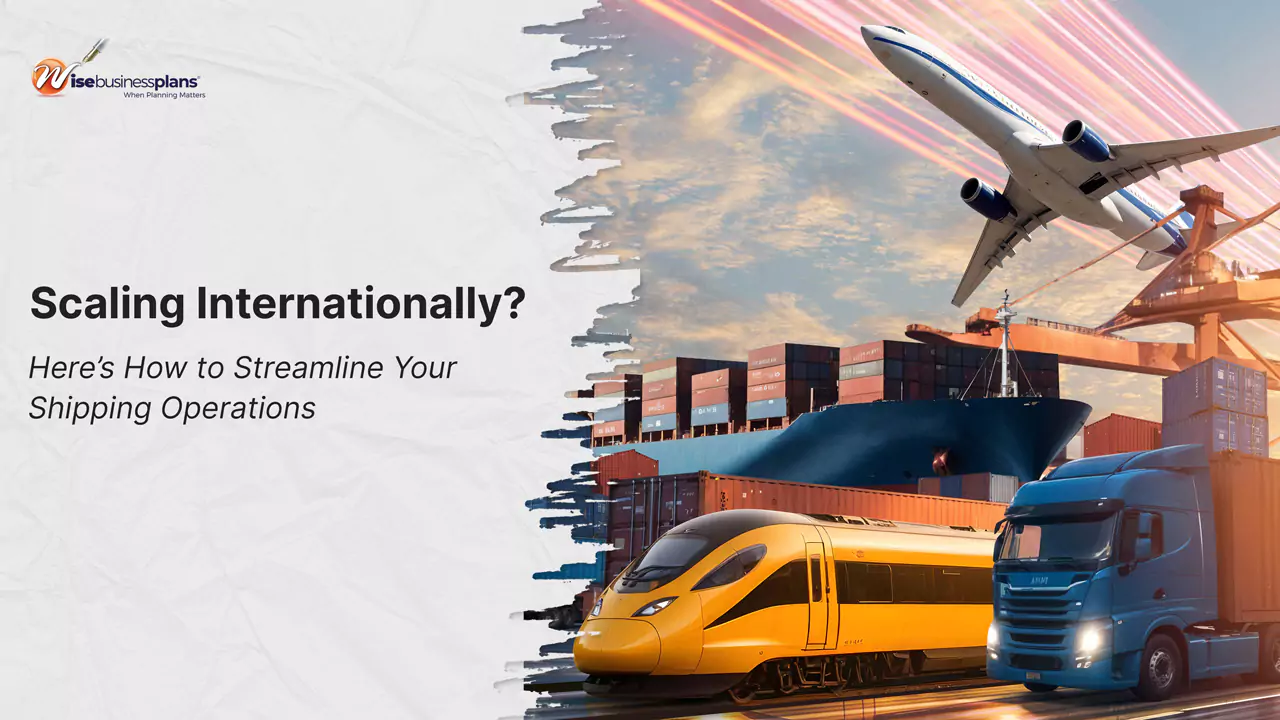Scaling Internationally? Here’s How to Streamline Your Shipping Operations
Table of Contents
- Understanding International Shipping Modes
- Digital Solutions to Simplify International Shipping
- Optimizing Freight Forwarding for Growing Businesses
- Streamlining Customs Clearance Procedures
- Risk Management in International Shipping
- Choosing the Right Logistics Partner
- Taking the Next Step in Your Global Growth Journey
You need to understand the simple elements of global shipping before sending your first international package. Your business expansion beyond borders needs proper planning and knowledge of complex rules that change from country to country.
The first step is to check if your products can legally enter your target countries. Many nations have strict rules about certain items. Dental products aren’t allowed in Algeria and used clothing can’t enter Bulgaria. You can find country-specific restrictions through Trade.gov, which gives detailed information about export and import rules for over 125 countries .
Your business needs should guide your choice of shipping mode. Air freight takes 1-3 days but costs USD 4.50-USD 8.00/kg. Ocean freight is slower at 20-45 days but costs USD 3000.00-USD 8000.00/container. This choice affects delivery times and costs by a lot.
Here’s everything you should know:
- Documentation requirements: Commercial invoices, packing lists, certificates of origin, and bills of lading are key. Accurate paperwork helps avoid customs delays.
- Customs clearance services: These experts work for you to fix any problems that come up. Most international shipping services include broker help for shipments under USD 500000.00.
- Declared values: Know the difference between carriage value (replacement cost) and customs value (true monetary value). The customs value is usually higher and decides import duties.
The terms of sale (Incoterms) must clearly show when ownership moves from seller to buyer. This determines who pays for shipping, insurance, and customs clearance services freight.
Start with markets like where you’re doing well now. Look at your web traffic and social media activity to find countries that already want your products. New businesses should use distribution centers to handle volume until they’re ready for their own facilities.
A step-by-step approach to these foundations will create a strong base for your international shipping. This sets up your business for global success.
Understanding International Shipping Modes
The right shipping mode choice sets the foundation for successful international logistics. Each transport option brings unique benefits that depend on your cargo type, delivery timeline, and budget.
Choosing between FCL, LCL, air, and land transport
Water, land, and air represent the three basic ways to move goods internationally. Sea freight leads global shipping and handles about 90% of all transported goods, with containers carrying 70% of this cargo.
Container shipping gives you two options: Full Container Load (FCL) works best when your shipment fills an entire container, while Less than Container Load (LCL) lets you share space with other shippers.
Time-sensitive deliveries move by air freight through passenger and cargo aircraft. Trucks and trains handle land freight, which usually connects different parts of international shipments.
Cost and time trade-offs in multi-modal shipping
A single contract covers multiple shipping methods in multi-modal transportation, which helps streamline processes. Air freight delivers fastest but costs the most, making it perfect for urgent or perishable items. Ocean freight offers budget-friendly rates for large cargo over long distances but takes more time. Air shipments reach their destination in 1-3 days while ocean freight needs 20-45 days. The rule is simple: faster shipping costs more money, while cheaper options need more time.
How shipment size impacts your logistics strategy
Your shipment’s size plays a crucial role in transport decisions. LCL seems cheaper than air freight for shipments around 3-4 cubic meters (CBM). The savings look good on paper, but once you add
Container Freight Station fees and inland trucking costs, the difference shrinks. Shipments over 10-12 CBM make FCL the better choice because LCL rates come close to FCL prices. Small, urgent packages work best with air freight. Larger shipments going long distances make sea freight’s lower costs worth the wait
Digital Solutions to Simplify International Shipping
Technology has changed international shipping from endless paperwork into a smooth digital process. Your business needs the right digital tools to handle complex cross-border shipping as it grows globally.
Shipping management platforms for growing businesses
Shipping management platforms link your business to multiple carriers through one user-friendly interface. These tools save hours by pulling orders from sales channels and offering better shipping rates. These platforms help companies grow their operations up to 40 times bigger.
The main features you get:
- Up-to-the-minute comparisons of global shipping rates
- Auto-import of orders from Shopify, eBay, and WooCommerce
- One place to track all international shipments
Automating documentation and compliance checks
Wrong paperwork can hold up shipments at customs for weeks. Automated shipping documentation software cuts processing time by about 80%. These systems stop data entry mistakes by creating shipping labels, bills of lading, and compliance forms from one source.
Integrating shipping with online checkouts
Your online store works better when it connects smoothly with shipping carriers. Shipping options can make or break your ecommerce checkout success. Smart integrations show exact delivery dates and multiple shipping choices during checkout, which means fewer abandoned carts. The system creates shipping labels right after order confirmation and sends customers real-time tracking updates throughout their delivery.
Optimizing Freight Forwarding for Growing Businesses
Your success in global markets depends on teaming up with freight forwarding services that can grow with your business. You should see freight forwarders as key allies in your global expansion, not just service providers.
Finding freight forwarding services that scale with your business
The world has over 100,000 freight forwarding companies, so you need to pick the right partner based on your needs. Small forwarders usually stick to popular countries where they have strong connections. Large forwarders can ship anywhere in the world. You should verify that your future forwarder can handle all your routes if you import from both major markets and unusual places.
These signs show if a forwarder can grow with you:
- Mid-tier forwarders ask “How would you like us to work with you?” instead of forcing their processes on you
- They use cloud-based forwarding software for up-to-the-minute data analysis and easy system integration
- Their pricing models adjust to your growing volume
Comparing shipping customs clearance services
Freight forwarders and customs brokers have different roles, though people often mix them up.
We used freight forwarders to handle shipping, paperwork, and rate negotiations. Customs brokers focus on clearing goods through customs. You’ll probably need both services for international shipping.
These days, many freight forwarders provide their own customs brokerage services. This puts everything under one roof. Having a single provider speeds things up and makes operations smoother, which helps when you’re growing faster.
Building mutually beneficial alliances with forwarding partners
Meeting face-to-face once a year helps build strong professional bonds. Pick forwarders who value relationships over just doing business.
Keep your service providers to three or fewer. Your team can build stronger connections and fix problems quickly by working with a small group. Paying on time builds your credibility and creates the foundations of a solid partnership.
A single communication platform prevents mix-ups between teams. You and your freight forwarder should use one system to check updates and documents. This makes everything more transparent and efficient.
Streamlining Customs Clearance Procedures
Customs clearance plays a vital role in your international shipping trip. Your goods will move smoothly across borders without getting pricey delays or compliance problems when you master this process.
Pre-shipment preparation to avoid delays
Accurate documents are the foundations of successful customs clearance. You should prepare all paperwork before shipping your goods. Commercial invoices must include precise details about buyers, sellers, goods descriptions, HS codes, country of origin, and incoterms. A good example would be listing “T-shirts, XL (50% cotton, 50% polyester)” with quantities and values instead of just “shirts”.
Your documentation needs to be consistent throughout. Even small discrepancies between commercial invoices, air waybills, and other shipping documents can cause customs delays. Make sure values, descriptions, and codes match exactly across all paperwork.
Platforms like Ship4wd can speed up the customs declaration process.
These tools let you submit documents electronically and give you a head start on clearance.
Leveraging customs clearance services freight specialists
Customs brokers are a great way to get help between your business and customs authorities. These specialists handle documentation, calculate duties, and guide you through complex international regulations. Their expertise helps you avoid unnecessary delays, penalties, and shipment seizures.
You might want to give power of attorney to your customs agency. This allows them to screen paperwork, file customs declarations, and prepare products for clearance on your behalf. Experts can handle the complexities of customs compliance while you focus on core business operations.
Managing customs clearance completed status efficiently
Track your shipment’s status in real time once you submit your paperwork.
You can spot and fix potential issues before they turn into serious delays with this visibility.
The status “Customs Clearance Completed” will show up on your documentation after successful clearance. This shows all necessary inspections, documentation checks, and duty payments have been processed. Your shipment gets cleared for final delivery at this stage.
Keep detailed records of all customs documentation to stay compliant. Most countries require importers to maintain these records for 5-6 years. These records will help with potential audits and future shipments.
Risk Management in International Shipping
Taking care of risks early makes all the difference as you expand your shipping operations internationally. Your goods face many hazards that can affect your bottom line and reputation while crossing borders.
What you need to know about cargo insurance
Cargo insurance protects your shipments from loss, damage, or theft during transit. Your cargo insurance covers events like natural disasters, vehicle accidents, cargo abandonment, customs rejection, acts of war, and piracy. This coverage goes beyond carrier liability, which only applies to areas under their control.
Insurance options fall into these categories:
- Per shipment coverage – An economical “pay-as-you-go” approach with no deductible
- Annual policies – These offer predictability for businesses that ship regularly
Your cargo value, shipping routes, packaging methods, and coverage limits determine the cost. A single large claim could be a big deal as it means that the total premiums paid several times over, making insurance a smart investment.
Why pre-shipment inspections matter
Pre-shipment inspection (PSI) examines finished goods in detail before shipment, usually at the manufacturer’s location. These inspections confirm that products meet quality standards and specifications.
PSIs look at workmanship, dimensions, functional capabilities, and packaging compliance . Quality standards differ between countries, so these inspections help maintain consistency in the global supply chain. This verification process lets you start optimization measures right away if problems come up. You end up saving time and money by preventing losses from incorrect products.
Smart ways to avoid penalties and delays
Automated compliance processes reduce errors by a lot, which keeps shipments from getting flagged at customs. Your shipping management software can confirm shipment data against requirements before submission. This helps spot missing information that might cause holds.
Keep current safety data sheets with complete information for all products, along with proper documentation. You must know exactly what you’re shipping – customs might classify items from medical devices to perfume as dangerous goods that need special handling.
Team up with customs experts who can screen paperwork, file declarations, and get products ready for clearance. You’ll need to keep records of customs transactions for six years plus the current year. These documents become crucial if an audit happens.
Choosing the Right Logistics Partner
The right logistics partner can make or break your international shipping operation. This choice becomes crucial as your business expands globally. You need to look beyond just costs to find a reliable freight forwarder.
Key features to look for in digital freight platforms
Digital freight platforms help streamline shipping operations with a tech-first approach. Here are some must-have features:
- User-friendly interface that makes navigation simple and helps you track reports through every shipment phase
- Access to logistics specialists who know the shipping process and can help when problems come up
- Expansive carrier network that gives you many reliable shipping options
The best platforms let you get quotes instantly, set up shipments, track your freight immediately, and handle paperwork all in one place.
Red flags to watch for in service-level agreements
These warning signs should grab your attention in service agreements.
Poor accountability shows up in SLA breach rules that make you responsible to notify the provider. You should skip agreements where you need to call about downtime instead of getting alerts from the provider. Watch out for fuzzy terms like “unexpected traffic increases” or “events beyond provider’s control”.
The biggest thing to check is the termination agreement. There should be just one clear option – you can leave whenever you want. This shows the provider wants to keep you happy, not trap you in contracts.
Comparing traditional vs. modern logistics providers
Traditional logistics providers build strong supplier relationships over time. They offer personal negotiations and tested methods. Modern providers use technology to ship faster, give more supplier choices, track everything immediately, and usually cost less.
Traditional forwarders shine with market experience and reliability. Digital freight matchers focus on automation and tech. The main difference lies in their style – traditional 3PLs fit new tools into people-focused operations, while digital providers start with technology first.
The best choice depends on what you need. Your business might like traditional providers if relationships matter most. But if you want speed and better efficiency, modern solutions could be the way to go.
Taking the Next Step in Your Global Growth Journey
Successful international expansion needs more than shipping logistics. Your global scaling strategy should prioritize market research before any operational decisions.
The numbers tell an interesting story – 95% of consumers live outside the U.S. This presents huge growth opportunities for businesses ready to look beyond their home markets. Growth potential and risk diversification make global expansion an attractive option, especially when facing economic uncertainty.
Your first step should be to evaluate market feasibility. Good research will show you where your products have the best chance of success. A complete analysis needs to look at:
- Your product’s market potential
- Local tax and regulatory requirements
- How well your offerings fit the culture
- Competition in your target countries
The next step is to create solid financial plans that cover operational costs, supply chain needs, and insurance requirements. Small Business Development Centers and government programs offer free help to businesses entering international markets.
Global expansion brings complexity that can overwhelm businesses that aren’t ready. Many companies team up with third-party logistics (3PL) providers who specialize in global shipping.
These partners handle customs clearance, documentation, and compliance while you grow your core business.
Companies with high shipping volumes might benefit from keeping inventory near their target markets. This strategy cuts both shipping times and costs. An employer of record (EOR) provides another option to enter new markets quickly without setting up legal entities.
Global expansion opens doors to new talent, resources, and raw materials that accelerate innovation. The process takes time – most companies need about five years to see returns on their international investments.
These broader business strategies work best when combined with the shipping approaches we discussed earlier. This comprehensive approach helps turn international challenges into real advantages for your business.













